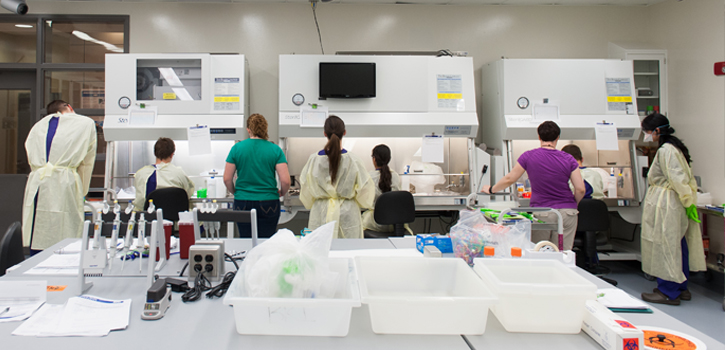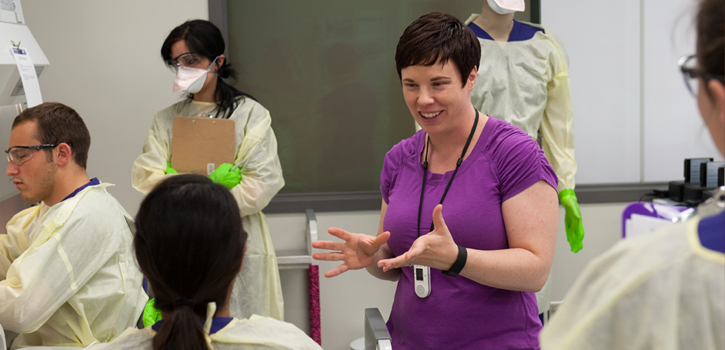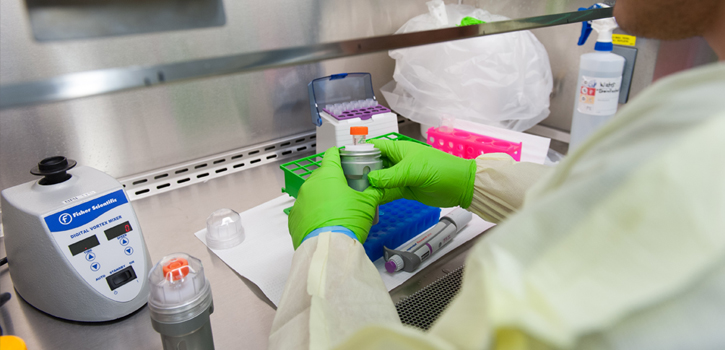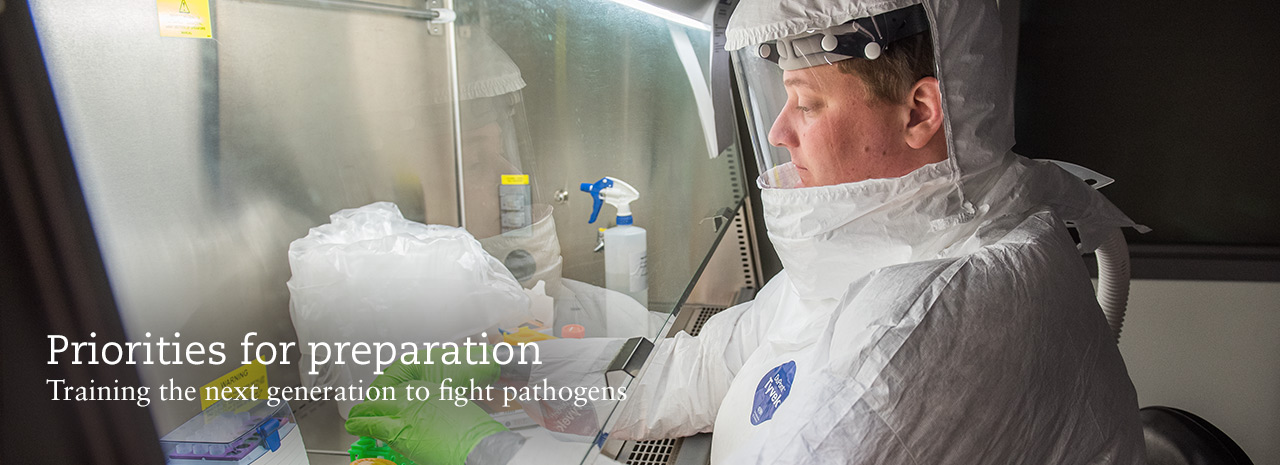Priorities for preparation: Training the next generation to fight animal, plant pathogens
By Stephanie Jacques
Watch a video that shows the procedures used to enter a biosafety level-3 laboratory.
Watch a video that shows the procedures used to exit a biosafety level-3 laboratory.
Sizzling bacon, smoky pulled pork, mouthwatering barbecue ribs and even the holiday ham could disappear from meals if African swine fever virus ever made its way to the U.S. While the disease does not affect human health, it is nearly 100% fatal to pigs in less than two weeks and could cause billions of dollars in economic damages for U.S. producers. An outbreak would have lasting effects on the pork industry.
“Within 12 years of the virus emerging in the country of Georgia, African swine fever has spread throughout most of Eastern Europe and across the entire continent of Asia into China, Vietnam and Cambodia,” said Daniel Madden, who researches the virus as a Kansas State University master’s student in veterinary biomedical sciences in the College of Veterinary Medicine. “It is very likely that future outbreaks will occur in areas that have never seen this disease before and we must be prepared.”
African swine fever virus and classical swine fever virus, another concerning disease, have not shown up in any U.S. swine populations yet. To keep it that way, Kansas State University is training the next generation of biosecurity and biosafety scientists, like Madden, while also conducting research to combat the most threatening agents to the world’s food supply, including swine fever viruses and many other pathogens.
The K-State Biosecurity Research Institute, or BRI, houses several multidisciplinary research programs on pathogens that affect animals, plants and insects as well as food safety and security. The institute has 14 biosafety level-3, or BSL-3, labs; biosafety level-3 agriculture, or BSL-3Ag, labs; plant pathogen research labs; and food safety processing labs in addition to 10,000 square feet of educational and training space.
“No other facility can do all that we do in one spot when it comes to plants, animals and insect work,” said John Henneman, BRI director of biocontainment operations. “We are unique and are working with agents that are not allowed at other nonfederal labs.”
In addition to swine fever viruses, the BRI also has research projects that are fighting wheat blast, a fungal disease that threatens wheat harvests; Japanese encephalitis virus, which lives in pigs and is transmitted to humans by mosquitoes; Rift Valley fever virus, a mosquito-borne virus that infects cattle, sheep and goats as well as humans; highly pathogenic avian influenza, which has been detected in more than 50 countries in Africa, Asia, Europe and the Middle East; and foodborne pathogens such as Shiga toxin-producing E. coli.
“We need to understand these diseases, identify what plant and animal strains are resistant, and develop rapid diagnostic tests, vaccines and treatments so if something hits this country, we can identify it and respond before it is widespread,” said Julie Johnson, BRI biosafety officer and assistant vice president for research compliance. “If we don’t have those things in place, we are vulnerable to exotic diseases. We cannot bury our heads in the sand.”
Next-generation preparation

As a land-grant university, K-State is using the research to train students and improve current practices. In the simulated BSL-3 training lab, which is one of only a few in the nation, students and researchers learn how to properly handle, decontaminate and dispose of high-consequence agents; how to safely enter and exit a containment lab; how to work in a BSL-3Ag lab; and what to do in an emergency while in the lab.
“The BRI is a great facility to help K-State students,” Johnson said. “We’ve had graduate students, undergraduate students and postdoctoral researchers train and gain experience at the BRI. There are very few places they can get this kind of research experience.”
According to Johnson, many of the students doing work at the BRI have their eyes on careers at the National Bio and Agro-defense Facility, or NBAF, which is under construction adjacent to the Manhattan campus. It will replace the aging Plum Island Animal Disease Center in New York and be the first biosafety level-4, or BSL-4, facility with the capability to handle livestock as part of its disease preparedness research. The proximity to NBAF and research partnerships will help students make important career connections.
“The training to work in the BRI enabled me to conduct my research on African swine fever virus,” Madden said. “Work in a BSL-3 setting requires careful planning and a significant amount of attention to detail. Materials must be handled in very specific ways to maximize safety, and meticulous records and inventories must be maintained for everything I do.”
Sustaining hands-on training

In the last 10 years, more than 400 people have been trained at the BRI to work in biocontainment, including more than 25 postdoctoral researchers, more than 80 graduate students and more than 50 undergraduate students. They must complete about 30 hours of training, including online, classroom and hands-on work in the training lab, followed by both written and practical exams. The training lab portion includes emergency response practice and mimics a real working lab.
New researchers learn how to properly dress in personal protective equipment, which includes gloves that are taped to protective sleeves; how to go through interlocking doors; how to use the eyewash station and other emergency equipment; how to work in a biosafety cabinet; and many other steps to maximize safety, said Cheryl Doerr, associate vice president for research compliance.
“Julie Johnson and her team do a fantastic job training people to work in these kinds of labs,” Doerr said. “They do all of that in the training lab before they ever enter a containment lab.”
K-State leader Nancy Jaax, College of Veterinary Medicine alumna and retired chief of the pathology division at the U.S. Army Medical Research Institute of Infectious Diseases, envisioned the training lab to allow students and researchers to practice processes with mock agents before they enter a lab with real infectious agents.
“The training lab was Nancy Jaax’s idea,” Johnson said. “Nancy insisted that we needed hands-on training to be effective.”
Nancy Jaax became a well-known name in connection with biosecurity and biosafety after the publication of Richard Preston’s bestseller, “The Hot Zone.” The book tells the true story of Nancy and her husband, Jerry Jaax, who worked to control a strain of Ebola in Reston, Virginia, in 1989. National Geographic also recently released a limited series inspired by the book. The concepts for safe practices that Nancy used when working with BSL-4 agents are similar to practices at the BRI for agents that require BSL-3 or BSL-3Ag safety.
While the BRI includes research of several zoonotic diseases that affect humans, agriculture-related pathogens are of special concern because of their economic impact and potential to affect the food supply.
“At the BRI, we are working on agricultural research,” Johnson said. “Many things we study are only dangerous to livestock or crops and not to people, but they are dangerous to people’s way of life.”
Madden and his adviser, Jürgen Richt, Regents distinguished professor in the College of Veterinary Medicine and director of the Center of Excellence for Emerging and Zoonotic Animal Diseases, or CEEZAD, are collaborating with federal researchers at Plum Island Animal Disease Center and international partners to stop African swine fever virus. They are developing rapid diagnostic tests that could detect DNA, viral antigens or antibodies to the virus so if the disease does show up in the U.S., it can be identified quickly and stopped before it spreads.
“There is no vaccine yet available for African swine fever and outbreaks of the disease result in severe animal and economic losses,” Madden said. “Rapid and accurate detection of the virus is critical for controlling epidemics and limiting spread of the disease. Tests that can be performed in the field or at farms would greatly facilitate early response efforts.”
Barrier to human error

Working with economically devastating pathogens requires not only extensive education but the utmost safety and security, which is integrated throughout the BRI. Like an onion, the BRI has layers of security, from the outside gates and the technological firewall to the security codes and 24/7 video monitoring.
“All the training and guidelines that are put in place are because people are human,” Henneman said. “The facility itself has layers of safety and the way it is designed offers multiple backups.”
Even the air movement in the building has an extensive backup system. Researchers work on samples in a biosafety cabinet, which has negative air pressure so air flows from the outside of the cabinet to the inside. This prevents any particulates in air from getting out of the cabinet, which also has high-efficiency particulate air, or HEPA, filtration. As a backup, the laboratory itself has the same setup with negative air pressure and HEPA filters to clean the air many times in an hour, according to Johnson.
All of these protocols in the BSL-3 and BSL-3Ag labs give students hands-on experience, help them build their resumes and prepare them for careers in fighting diseases and securing the nation’s food supply.
“The training I received here has been invaluable to my work,” Madden said. “K-State possesses the infrastructure to conduct research on high-consequence and emerging pathogens. The BRI is one of the few facilities capable of handling research on dangerous livestock diseases in a high-containment setting. The breadth and depth of experience I have gained here is simply not available at other universities.”

